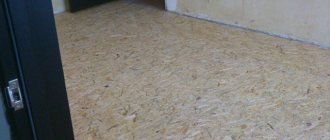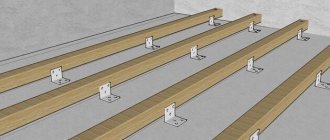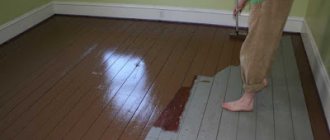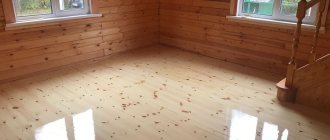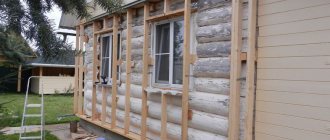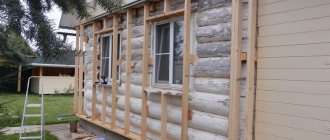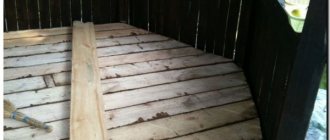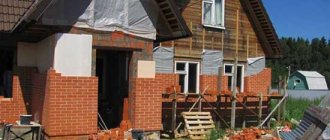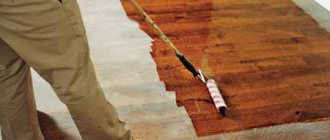What to lay on the floor: fiberboard or chipboard. Chipboard fiberboard mdf plywood OSB for laying on floors
High-quality floor repair depends on the correct choice of base. The choice of modern materials is so wide that it is often difficult for the average person to decide what exactly he needs. For flooring on a wooden base, particle board materials are most often used. But what should you choose, chipboard or MDF? How do OSB boards differ from plywood and what will be better for flooring?
Distinctive characteristics of materials
Knowing the basic parameters of sheet materials, it will not be difficult to compare their characteristics and make a choice.
Let's compare the characteristics
Based on the basic characteristics of the materials, you can decide on the choice of base floor:
Installation method
Attaching sheets to joists does not involve any particular difficulties:
Step 1. We measure the square footage of the room, stock up on the necessary materials (chipboards and hardware).
Step 2. Lay the first sheet on the floor surface, fasten it to the joists using self-tapping screws, check the stability of the structure and compliance with the level
Step 3. In this way, we attach each sheet one by one, checking the overall floor level.
What to choose?
To choose the most suitable material, you should not focus on price and beauty
It is also important to take into account the operating conditions, the specifics of the room being repaired and the decorative coating. Thus, for finishing the bathroom and kitchen, slabs with increased moisture resistance are used. For fragmentary floor repairs, less dense sheets will be sufficient; for constructing a full-fledged base, it is better to take the thickest and most durable slabs
For fragmentary floor repairs, less dense sheets will be sufficient; for a full-fledged base, it is better to take the thickest and most durable slabs.
Foundation Type: When Looks Matter
Before applying wallpaper to paint, determine the type of coating:
- Oil – has a stable structure, is moisture resistant, sits well on the surface and forms a protective layer. Has a strong smell.
- Water-emulsion - made on a water basis and tightly impregnates the base after drying. It is odorless and repels moisture well.
If, when removed with a spatula, the material falls off in layers, it is an oil base; if it comes off very poorly and has practically merged with the structure of the wall, it is a water-based material.
Preparatory work
The preparation consists of the following:
Hard brushes and rollers on a natural (not foam) base are suitable as working tools for painting fiberboard. The other options are unsuitable, since they will not be able to hide the fibrousness of the original surface, and traces from layers of paint will be very noticeable.
Good results are obtained by painting fiberboard with a spray gun or spray gun, however, the costs with this method of painting will increase. Mechanized painting is justified only for large areas of processing.
How to treat chipboard for moisture resistance?
Treatment
Aquastop is an excellent alternative to sealant. Apply with a brush twice. After complete drying, it forms a layer on which you can even glue the edge (according to furniture makers - I haven’t tried it myself).
Interesting materials:
What is a cross-axle differential lock? What is a bun on a wheel? What is a facial booster? What is a booster on an induction cooker? What is a CD changer? What is a tip in a restaurant? What is the frequency range in headphones? What is an EGR sensor for gasoline? What is an EGR sensor? What is a phase sensor on a VAZ 2114?
How to wisely choose fiberboard for the floor
First of all, it is necessary to get an idea of the nature of future loads on the floor to be covered, the conditions of dampness or dryness and the regime of low, normal or high temperatures.
The most commonly used standard size of one slab for most floors is 1.7 m x 2.745 m with a thickness of 3 - 3.2 mm. They also produce moisture-resistant slabs with oil impregnation 6 mm thick, which are advisable to lay on the floors of the first floor and in wet rooms.
Selecting fiberboard sheets for specific purposes is not difficult
By brand they are divided into M - soft fiberboard sheets, T - hard, ST - super hard with an unpainted or painted front layer. Based on the purpose of the rooms, slabs of a suitable brand are selected.
Harder boards (hardboard) are used as a substrate for laminate (laminated flooring), parquet or parquet boards, linoleum and for better thermal and sound insulation of the floor. In addition to installing floors, such fiberboard sheets are used for installing interior partitions, wall cladding, and for cladding panel systems.
Give preference to trusted manufacturers
Particle boards can be painted and laminated. All general products designed for interior painting of wood surfaces are suitable for painting boards.
In the event that the floor is leveled with subsequent painting, it would be correct to choose special decorative fiberboard sheets, which, like parquet, can be laid out in patterns.
When purchasing floor slabs, you should pay attention to the fact that all selected canvases are smooth, have the same surface appearance, size and thickness
When purchasing this material, it is important to take into account the characteristics of the bars. They must be coniferous wood of second or third quality, dry, treated with special fire-bioprotective compounds, without visible large knots, fungi and other similar defects. However, small cracks in the wood are acceptable
If mold and fungi are found, these areas are cleaned and a fungicidal solution is applied on top of them to prevent damage to the new coating.
However, small cracks in the wood are acceptable. If mold and fungi are found, these areas are cleaned and a fungicidal solution is applied on top of them to prevent damage to the new coating.
They must be coniferous wood of second or third quality, dry, treated with special fire-bioprotective compounds, without visible large knots, fungi and other similar defects. However, small cracks in the wood are acceptable. If mold and fungi are found, these areas are cleaned and a fungicidal solution is applied on top of them to prevent damage to the new coating.
During transportation and storage, the boards must be protected from dryness and humidity, dirt, sunlight, contact with the ground, dents and scratches. Fibreboard is stored face down on a flat base. If necessary, support wood is used at 0.5 meter intervals.
During transportation, make sure that the plates are not damaged
Coating protection
Finish coating of hardboard with varnish
Although paints allow you to form a fairly reliable protective coating by applying them in several layers, you should not forget about additional protection, which will also have a good effect on the aesthetic appearance of the finished base in your room or apartment.
One such solution is Varnish. To prevent the varnish from curling and peeling after application, pay attention to the composition of its base. It needs to match the composition of the paint base that has already been applied to the floor.
Although painting with varnish is not a necessary procedure, it will help make the finished coating more resistant to abrasion and easier to care for.
Advantages and disadvantages of fiberboard
Fiberboard is made by pressing waste left over from woodworking. When exposed to high pressure and high temperatures, a smooth and lightweight material is formed. Due to their advantages, the slabs can be used for cladding walls, floors, and you can often see fiberboard on the ceiling. The material is also widely used for the production of cabinet furniture.
Among the main advantages are:
Like any other material, fiberboards have their downsides, but there are only two of them:
The slabs are excellent for arranging rough or finished floors, but their surface must first be carefully treated.
On the video: types of wood boards - characteristics and features.
Dyeing technology
The technology for painting fiber board is no different from painting any other materials. The process is carried out in several stages:
Required Tools
To paint a fiberboard floor you need to prepare:
Next, the preparatory stage begins.
Surface preparation
It is imperative to take into account an important nuance - before performing any work with fiberboards, the fiberboard is first brought to a certain humidity. Otherwise, over time, the slab will move in waves, thereby ruining the floor or wall. Moistening fiberboard is simple: moisten the back side of the sheet with warm water, and then fold the sheets in pairs. The slabs should be left to dry for a day.
Floors are often made from fiberboard
In order for a fiberboard floor to boast the same service life as a wooden base, it is important to properly treat it, including painting. Hardboard floors are very porous - any paint will be absorbed there in a significant amount than into a concrete or wooden floor
Experts first suggest covering the surface with a primer - if this is not done, then a positive result can be achieved, but the paint consumption will be very large.
Paint for fiberboard should be applied only to the glossy side of the sheet - the other side is not suitable for this. On the other side, a primer is more appropriate. Due to the peculiarities of its manufacturing and structure, the slab is capable of absorbing 4 times more paint, and applying a primer is one of the stages before painting.
Primer materials are now widely represented on the construction market. Fiberboard and hardboard are traditionally treated with drying oil - this is an affordable and practical product. But the drying oil should be heated to 40 degrees.
Before applying the primer, the slabs are thoroughly cleaned of dust. This can be done either with an ordinary rag or with a vacuum cleaner. The cracks in the floor are sealed with tape or reinforced tape. The entire remaining surface must be degreased - you can use a solvent or alcohol.
The primer is applied with a roller. Experts recommend applying several layers. When the slab is impregnated with drying oil in three layers, the resistance of the material to moisture significantly increases. To increase the service life of hardboard, it is necessary to process it after the cutting is done, but before the laying process.
Paint selection
Painting of fiberboard is carried out using any coloring enamels, but it is better to choose super-hard types of paints. They are marked “ST”. It is these dyes that will give the floor maximum resistance to wear. Oil and alkyd paints are used as alternatives.
Water-based paints are not suitable in this case - they will not be able to adhere to the fiberboard coating. The slab contains paraffin - it will repel paint.
You can also use decorative varnish instead of paint. There are also some tricks with which you can create unusual color schemes. So, to imitate natural wood, you can apply liquid bitumen varnish to the surface with a brush. To create a paint with a “plastic surface” effect, glossy compounds are used.
Painting process
For painting work, experts do not recommend using foam sponges or brushes - these tools will not allow you to distribute the dye evenly over the surface. As a result, divorces will remain. The best choice is a spray gun, but a fur roller will also work. For work on small areas, you can use paint in cans - the process will go much faster.
The paint in the jar is thoroughly mixed and, if necessary, diluted with a solvent to the desired consistency.
How to paint fiberboard? First, the first coat of paint is applied. If it seems that somewhere the dye has been absorbed poorly or too well, then the defect is not corrected, but wait until it dries completely. The next layer is applied to the painted layer after the first one has completely dried. It takes about a day to completely dry.
You can’t make a common mistake and create drafts in the room - the paint won’t dry faster than necessary. For the second layer the paint should be thick. The third layer is applied after the second has dried. After painting, fiber boards not only improve aesthetically, but also increase their strength and other characteristics.
Painting of fibreboards
Peculiarities
The photo shows fiberboard slabs.
Before you paint fiberboard, you should find out what kind of material it is and what its features are. As the name suggests, these are boards made from wood fibers. Fibers are obtained in different ways: by processing wood chips and shavings, plant fires, crushed wood and other waste from the woodworking industry.
The fibers are collected and pressed when heated with the addition of synthetic resins, as well as water-repellent additives (paraffin, rosin) and pectol. Soft varieties of this product can be produced without the addition of resins, due to the lignin released from the cells of wood fibers during pressing. Various targeted additives are also added to the boards - fire retardants, fungicides and antiseptics.
This is what wood fiber looks like after recycling.
As a result, fairly strong and smooth slabs are obtained, which are characterized by the following qualities:
- High strength . The ST series slab grades can be used for the construction of floors, carriages, furniture and other structures that require the ability to withstand high mechanical loads;
- Low price. Due to the fact that the material is produced from waste, its cost is significantly lower than the cost of solid wood or plywood. This explains the popularity of this product in various fields of production and construction;
- Moisture resistance . With appropriate treatment, fiberboard can withstand high humidity and be used as an enclosing structure in car building, packaging production and other areas of economy and industry;
- Durability . Factory impregnation with special preparations makes the slabs unsuitable for feeding fungi and bacteria, as well as insects and other pests. This allows the material to serve for a long time without any significant changes in composition and structure.
Important! Modern MDF material is a type of fiberboard; only fibers of certain types of wood and special pressing technology are used for its production.
Front (left) and back side of the plate.
Attention! In addition to the general characteristics, we want to highlight one more, at first glance, insignificant feature. This feature lies in the fact that, due to some technological subtleties, the material very actively absorbs and absorbs liquids. This is important from a painting point of view.
Materials
Choosing paint for work.
Any wood paint is suitable for working with slabs. Since floor coverings are most often made from this material, let's talk about this area of finishing.
Features of working with fiberboard
How to process chipboard, how to fasten it and how to cut it - these are the main questions that have tormented planer and hammer craftsmen for quite some time. For example, few people know how to glue fiberboard onto fiberboard, because even liquid nails and epoxy adhesives do not always cope with this task. In this case, regular PVA construction glue or special adhesives for gluing fiberboard can help.
How to cut fiberboard at home? Again, very simple - with a mounting knife or a hacksaw
It is worth paying attention to the knife cutting technology. The knife blade must be sharp; it is best to cut using a metal ruler and slowly and carefully, otherwise there is a possibility of damaging your fingers if the blade breaks.
There are also several roller-type devices for cutting fiberboard, one of which is shown in the photo.
Watch this video on YouTube
Frequently asked questions about surface finishing of fiberboards. Wallpapering or painting. The fact is that fiberboard does not accept moisture very well and has low adhesion. In other words, paint does not stick well to the fiberboard surface. For this reason, the surface must be primed before painting. For convenience, you can prime the sheets before installing them on the frame.
There is a separate issue with preparing the fiberboard surface for wallpapering, since this material does not tolerate moisture well, before applying wallpaper glue, which can cause warping of the panels, it is worth painting the surface. Then further finishing will not cause questions or problems. Here is the answer to the question whether it is possible to glue wallpaper on fiberboard. It is possible, but you need to prepare the surface.
Often, when using products made from fiberboard, defects appear on them; these can be either mechanical damage or traces of use. Traces of use in the form of dents and scratches are quite easy to repair. To do this, you just need to putty the damaged surface, then paint it, or cover the surface with self-adhesive film.
Hole in the door, and what to do about it?
Before filling a hole in a fiberboard door, we trim off the uneven and dented edges of the hole so that the edges of the hole are smooth, without dents or cracks. Then we install partitions inside the hole; these can be fixed bars, pieces of fiberboard or crumpled, thick paper. The next step is to fill the hole with polyurethane foam; after it has hardened, it is necessary to cut off the protruding foam flush with the surface of the door.
After this, the surface of the door around the hole and the foam is puttied, for example with epoxy resin. Once dry, everything is sanded again with fine sandpaper, which is best secured to a wooden block. This will allow you to achieve a smooth surface. Then you need to restore the appearance of the door itself, this can be done either by painting, or by sticking a self-adhesive film with an imitation of wood texture, or by veneering.
Repairing a door is a complex and painstaking task.
If there is a through hole on any base, most often this happens when laying fiberboard on a wooden floor, the protruding board can rub the sheet right through. In this case, it is best to change the entire sheet, at the same time deal with the board, process it with a plane or secure it with self-tapping screws. But often this is not possible, so you can do the following. Carefully trim the worn hole with a mounting knife until you obtain an even geometric shape. Then cut out a patch of the same size from a piece of fiberboard and insert it into the formed socket, securing it there with screws or glue.
Thus, despite some peculiarities in the processing of fiberboard, the material is quite subject to manual work and repair at home.
Wood composites can be processed
Subsequent treatment of plywood to maintain moisture protection
Treatment of plywood from moisture: during installation and operation, plywood sheets may lose their moisture protection properties. Due to mechanical, thermal and light effects, the special protective coating can crack and even peel off. How to proceed in this case.
It is necessary to treat the places where the plywood is attached to the base. Also, if cracks appear, you should immediately begin restoring the protective coating.
What should be done for this? First of all, take sandpaper and remove those layers that are already weak, then begin applying a new layer of protection. Only in this case will the plywood sheet last a long time and justify the money spent on its protection.
Technology for laying laminate flooring on a wooden floor
After leveling the floor using one of the above methods, begin laying the laminate.
Laying the substrate
A layer of waterproofing is placed on the leveled floor. As a rule, in this case, thick polyethylene film is used. After this, the substrate is laid. The substrate performs the following tasks:
The underlay is laid on the leveled floor and only after that can the laminate be laid
Manufacturers offer laminate backings made from different materials:
Most often, a polyethylene foam substrate with a thickness of 1–3 mm is used. In principle, choosing a substrate of greater thickness does not make much sense, since over time it will still cake. The substrate is produced in rolls and sheets. Polyethylene foam is laid loosely with a slight overlap. Other types of substrate are laid end-to-end. To prevent movement during laying of the laminate, the edges of the substrate can be taped.
Polyethylene foam roll backing for laminate
Laminate preparation and marking
Before installation, the laminate must undergo “acclimatization.” It is brought into the room where it will be laid and left without unpacking for 2-3 days. This is necessary to bring the material into balance with the temperature and humidity of the environment.
The laminate is brought into the room in advance
Laying begins from the far corner of the room. Most often, laminate flooring is placed perpendicular to the window. This installation method, perpendicular to the incident light, makes the joints less noticeable. Parallel and diagonal laying is also possible. Diagonal laying requires careful adjustment. It is recommended for small narrow rooms, as it helps to visually expand them.
Diagonal laying of laminate
Markings are made on the floor. Measure the distance and calculate how many boards will be laid. Take into account that when laying each subsequent row, it is necessary to offset the laminate panel by half, thereby preventing the seams from matching. If the width of the last board is less than 1/3, then it is better to lay the first row from boards sawn in half.
Laying laminate flooring on a wooden floor with your own hands
The method of laying laminate depends on its type:
Technology for correct joining of laminates Technology for laying laminates with a “Click” lock
Laminate with “Lock” lock. To secure a board with such a lock, insert a tenon into the groove and lightly tap on the opposite end until it clicks.
Laminate laying technology with Lock
Important! Do not tap the laminate directly on the end, as this can lead to deformation of the lock. This action must be performed through a small block. This type of laminate is placed staggered
If a whole number of boards are laid across the width of the room without any remainder, then through the row one board is cut in half and laying begins with this half of the board. A wedge of lath is installed between the wall and the floor, leaving a temperature gap of 3 - 5 mm
This type of laminate is placed staggered. If a whole number of boards are laid across the width of the room without any remainder, then through the row one board is cut in half and laying begins with this half of the board. A wedge of lath is installed between the wall and the floor, leaving a temperature gap of 3 - 5 mm.
We have described in detail how to lay laminate flooring on a wooden floor correctly so that the result does not disappoint. In the video, a specialist will tell you how to prepare the floor for installation of this flooring.
Interesting on the topic:
The procedure for preparing the base
The rough foundation for fiberboard necessarily requires proper preparation. To do this, it is imperative to remove the baseboards along the walls so as not to interfere with the work. Wooden floors are carefully inspected for strength and integrity - it is important to pre-fix any loose boards. Significant unevenness in the floor is corrected - they are planed. This procedure is not easy, and it is better to use special equipment, which you can rent or call a specialist who has it.
Alignment by scraping
Also, measures to prepare the base include careful removal of construction debris, sweeping of dust, and sealing cracks in the floor with putty.
Advice! In old buildings, wooden floors are additionally treated with antifungal mixtures.
Old wooden floors need to be properly prepared
Sequence of laying linoleum
Like fiberboard, linoleum should rest in the room where repairs are being carried out. For this, 2-3 days are enough: during this time the material adapts to the temperature and humidity conditions, and after installation it will not expand or, conversely, contract. Sheets of linoleum are spread on the floor so that they take the correct shape. If the material is going to be laid in strips, you need to make sure that the pattern of the floor covering matches.
Linoleum must be glued to the flooring; it is not recommended to use self-tapping screws: they will ruin the appearance of the floor. To perform installation work, special glue is used. It is applied to the floor using a notched trowel, avoiding lumps and untreated areas. When the glue on the fiberboard boards thickens a little, it is applied to the back side of the linoleum sheets, and then they are laid on the floor surface. To properly distribute the glue under the linoleum surface, the flooring sheets are aligned from the center to the corners.
Often laying linoleum on fiberboard is done in a different way. Instead of gluing the material, it is fixed using a furniture stapler. This tool is designed for working with wood and wood waste boards, and will ensure high reliability of fastenings.
Sheets of linoleum should not be laid close to each other on the floor, but with a small gap. The size of the gaps is usually one third less than the thickness of the sheets. Outwardly, these gaps are invisible, so there is no need to worry about the appearance of the floor covering. They are designed to remove moisture that accumulates between linoleum and fiberboard boards and extend the life of the coating.
Sometimes linoleum is installed on a painted surface. This usually occurs when there are no other materials available to assemble the deck other than painted fiberboard. In this case, laying linoleum on the floor is allowed only if the paint has dried long ago, is evenly distributed over the surface of the flooring and does not contain lumps. Typically, linoleum is not attached to a painted base.
There may be several reasons for repairing the floor: unevenness of the base, various damages, the need for insulation, and the like. Today there are many materials available on the market, which makes it very difficult to choose one or another floor covering.
However, no matter what material you choose, be it laminate or parquet boards, in any case you cannot do without a solid foundation for laying new flooring. To create it, they also use different materials, but hardboard would be the best option. The material is one of the varieties of fiberboard (fibreboard).
Advantages of the material
Fiberboard
The advantages of this building material are as follows:
- low cost;
- ease of installation;
- environmentally friendly, since the board contains natural wood;
- dense structure, due to the fact that fiberboard is produced by hot pressing of sawdust. The addition of antiseptics and synthetic resins gives it better properties even compared to natural wood flooring;
- high resistance to mechanical damage;
- strength and durability, but subject to proper use. This involves creating a protective layer of waterproof paint or water-repellent varnishes, which, moreover, can significantly improve the appearance of the coating;
- Excellent heat and sound insulation, which is why fiberboard is often used as insulation. The slabs are laid on the first floors of multi-storey buildings, as well as in private houses, that is, in cases where the floor surface cannot be raised to a greater height. Insulation of any floors is usually carried out using types of fiberboard such as PT-100, as well as M-20. Different coatings are laid on top of the fiberboard. The exception is thin linoleum or ceramic tiles;
- The flat surface of this material allows you to get a perfectly flat floor on which you can install any covering.
Dimensions of fiberboard sheets
Applying paint
When painting hardboard, we do not recommend using brushes or a foam sponge. When using these tools, the paint will not lie evenly on the floor and streaks may appear. To paint a fiberboard floor, it is best to take a fur roller, or, if you have one, a spray bottle. If you need to paint a small area, you can initially purchase paint in cans if it is comparable to the price of a large can. Since the paint in the can also has a spray bottle, it will be more convenient and faster to paint.
And so, after our primer layer has completely dried, we take the selected can of paint and thoroughly mix the contents. If the paint seems thick to you, you need to add a little solvent to it and mix again.
Painting hardboard sheets will not only make them pleasant to look at, but will also extend their service life. It is also worth considering the important point that the composition of the primer base matches the paint base.
Necessary tool
So, let's start in order. Just before preparing the surface, we will collect everything necessary that we may need during the work. First of all, you should stock up on the necessary tools so that the work can be completed in the shortest possible time and with less effort.
- Paint roller with a nozzle made of fur rather than foam rubber
- Brush, some areas cannot be painted with a roller
- Drawer for paint
- Spatula if application of sealant is expected
- Vacuum cleaner for cleaning the surface after grouting
Now that you have prepared all the tools, let's move on to painting. But there is no need to rush here either. Next, preparatory work is needed.
Procedure for laying joists and fiberboard on the floor
Please note that materials should not be stored in a damp place. It is better to place the timber horizontally and the fiberboard vertically along the wall. In this case, it is desirable that the room be at room temperature.
The lags are laid on a previously prepared surface. Preparation is carried out using a cement screed. The fibreboard installation method is suitable for both leveling the surface and completely replacing it.
Before work, we recommend getting rid of large differences, unevenness or slopes of the floor. Installation of logs can be done using the diagram below.
If this is your first time creating a fiberboard floor, we recommend watching the instructional video. Many hire professionals to install the logs, and install the slabs themselves. The first step is to carefully inspect the surface for the presence of fungus or mold and, if found, get rid of it. For more information on leveling the floor, watch this video:
Then you will need to treat the floor areas with a primer and antiseptic to prevent the possible appearance of bacteria.
Fiberboard sheets must touch on the joists
The procedure for installing fiberboard on logs is as follows:
Installation using glue has the following nuances:
Finally, you will need to remove all remaining adhesive. The space between the sheets can be treated with putty or using reinforcing tape. The fiberboard floor can then be varnished or painted on top to provide additional protection.
Source
Selected moments
If the fiberboard is located on the floor, then the finished surface should be varnished not in one, but in two layers.
Sometimes purely decorative coloring of plastic is used. Then, on the contrary, they try to emphasize its fibrous primary texture. To do this, painting is done with bitumen varnish using a small brush.
To achieve the effect of a smooth fiberboard surface, it is painted in light or even white colors, and to achieve a matte surface, water-dispersion based paints are used.
Recent comments
- admin to the entry of top domestic motor oils
- Marat to the entry of top domestic motor oils
- admin to the entry of top domestic motor oils
- Alexey Orekhov on top domestic motor oils
- admin to the post what is better to listen to while running
© 2022. Product rating - TOP 10.
All rights reserved. Attention! The information published on the site is for informational purposes only and does not constitute a recommendation for use. The Materials may contain information intended for users over 18 years of age. 18+
This site collects, stores and organizes cookies to improve the functionality of the site. By continuing to use it, you consent to the processing of these files.
